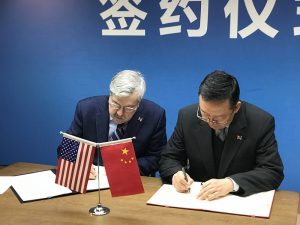Terry Branstad has been the American ambassador to China for over three years now. And among President Donald Trump’s hawkish China advisors, from Mike Pompeo to Peter Navarro to Matt Pottinger, Branstad sticks out, not only as one who has generally avoided the spotlight (especially in comparison to those mentioned), but also as one of the last remaining prominent American torchbearers for a pro-business, pro-China-engagement position.
This raises a question: where have those other voices gone?
Traditionally, pro-business voices, especially on the right, were among those pushing for closer ties with China. In the United States, they previously found common cause with human rights advocates, whose hopes for China were encapsulated in Bill Clinton’s address when China acceded to the WTO with U.S. help. As then-President Clinton put it, “The more China liberalizes its economy, the more fully it will liberate the potential of its people…And when individuals have the power…they will demand a greater say.”
But that economic liberalization didn’t bring about political liberalization, and ties have worsened in the last decade, accelerating further since the ascent of Xi Jinping in 2012 and election of Donald Trump four years later.
American business-friendly voices have since coalesced around a more China-skeptical position. For example, Derek Scissors, a former Department of Defense official in the George H.W. Bush administration and current scholar at the American Enterprise Institute, said he was wrong when he supported China’s WTO accession in 2001. And Robert Cassidy, one of Clinton’s senior China negotiators, has said that in hindsight, he has been “incredibly disappointed” with the results of China’s WTO accession.
Conservative media mogul Rupert Murdoch, who had invested heavily in Chinese media outlets and, as one author put it, “threw his worldwide media empire behind China’s bid” to enter the WTO in 1999, severed ties with Chinese partners in 2014 after those business efforts proved unsuccessful. Now his media networks, led by Fox News, are now disproportionally criticizing China and its role in the COVID-19 pandemic, and those talking points are being picked up by Trump and his supporters.
What happened? As Joe Renourd put it in the National Interest, “Alongside long-standing American business concerns such as IP theft and currency manipulation, many now fear losing global market share to new Chinese ventures.” Trump-era tariffs have escalated these concerns for some, and the COVID-19 pandemic may be the last straw for U.S. companies that realized their dependence on China for medical supplies during the pandemic.
Now more than 50 major multinationals, including Google and Nintendo, have pulled their supply chains out of China, and a majority of U.S. manufacturers are considering further altering their supply chains due to COVID-19, according to an industry survey earlier this year.
But should the United States allow business with China to go by the wayside?
Opening the world to China economically cannot be expected to have liberalizing political effects for China; that notion has been revealed to be more wishful than realistic. However, two truths remain: one, trading partners need not have the same systems of governance to be good trading partners; and two, trading partners need not trade everything they have with each other.
There is an export-based opportunity here for U.S. producers. Rather than throw the baby out with the bathwater, business-minded policy analysts could think of economic and national security interests on a spectrum: on one end would be high-tech military and security technology, and on the other would be low-risk exports such as corn, yarn, and mattresses.
Such a framework would incentivize free trade of items in the latter category, and could leave necessary export controls in place while allowing businesses to increase other exports to China. It could also stabilize the U.S.-China relationship in a way that a broad-based decoupling will not.
According to the Observatory for Economic Complexity, the top three exports from the United States to China in 2017 were aircraft (10 percent), soybeans (9.3 percent), and automobiles (8.7 percent). Taking just these three as examples, it is quite possible to envision an export security spectrum going from soybeans (least risk) to automobiles (more risk) to aircraft (most risk).
There may always be risks to exporting products. But there also have to be ways to measure the risks. Are soybeans national security interests in the same way semiconductors are? Probably not, and the U.S.-China Phase I trade deal essentially admits as much when it states that both the United States and China “intend to intensify cooperation in agriculture,” and lays out targets for China to purchase $32 billion more in agricultural products.
These goals, especially in the wake of the COVID-19 pandemic, may be too unrealistic. But for those who have been withdrawing from the Chinese stage, the framework of an export security spectrum might give an opening for some in business to reclaim that space.
James Haynes is a researcher at a DC-based think tank, a recent Princeton graduate, and editor of the China Biotech Bulletin.

































